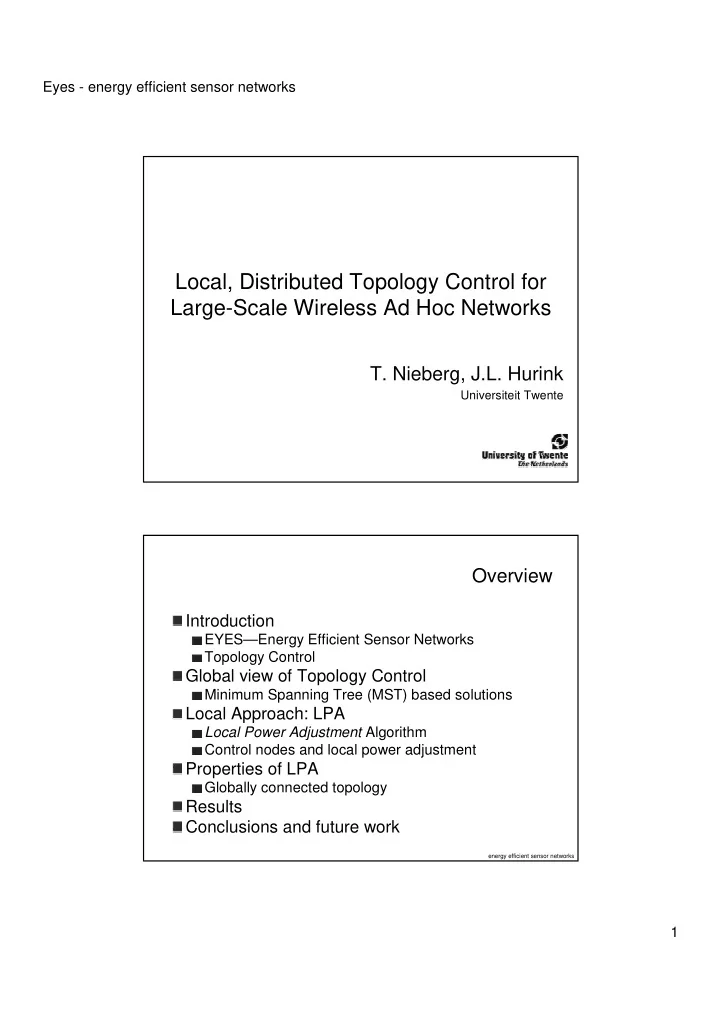

Eyes - energy efficient sensor networks Local, Distributed Topology Control for Large-Scale Wireless Ad Hoc Networks T. Nieberg, J.L. Hurink Universiteit Twente Overview Introduction EYES —Energy Efficient Sensor Networks Topology Control Global view of Topology Control Minimum Spanning Tree (MST) based solutions Local Approach: LPA Local Power Adjustment Algorithm Control nodes and local power adjustment Properties of LPA Globally connected topology Results Conclusions and future work energy efficient sensor networks 1
Eyes - energy efficient sensor networks ���� ������ ��������� ��������������� Basic Components Small intelligent devices Sensing & Processing Short-Range Radio: Wireless Communication Topology Main Concern: ENERGY Need long lifetime on single battery e.g. reduce number of transmissions, compression, en-route data aggregation … => Save energy by reducing signal strength However, still need connectivity � energy efficient sensor networks �������� ��������� �������� Theoretically: Power levels for nodes to reach each other given as regular function of distance Only valid in ideal settings: open field —no obstacles Practically: Reflection, interference from walls and objects, direction of antenna … => LPA: no localization, no “ideal” settings Only information about signal strength needed to reach neighbor is known e.g. RSSI, neighborhood detection schemes … energy efficient sensor networks 2
Eyes - energy efficient sensor networks ������������� ����� Directed Graph ( , ) G = V A Each arc represents possible communication Weights are given to the arc , ( , ) > 0 ( , ) ∈ p u v u v A representing the signal strength needed to ( ( , ) ≤ ) communicate p u v P max P u ∈ Each node can adjust its signal strength V u { | ∈ } P u V Power assignment for all nodes u New communication graph G P __ Induced bidirectional graph ( , ) G = V E P Only bidirectional communication considered [ , ] ∈ ⇔ ( , ) ≥ ∧ ( , ) ≥ u v E p u v P p v u P P u v energy efficient sensor networks �������� ������� ������� ��������� Maximal Power Adjustment Find power settings such that the resulting graph is bidirectionally connected, and max the maximum signal strength, , is minimized. P i ∈ V i Minimize time to first node death Total Power Adjustment Find power settings such that the resulting graph is bidirectionally connected, and ∑ ∈ V P the sum of power levels, , is minimized. i i Equivalent to average signal strength energy efficient sensor networks 3
Eyes - energy efficient sensor networks ������ ���� Consider Minimum Spanning Tree T Adjust power levels : = max ( , ) P p u v u {[ u , v ] ∈ T } => induced bidirectional graph is connected T P Theorem 1: T The corresponding solution is optimal for P the Max. Power Adjustment problem. Theorem 2: T P The corresponding solution is a 2-approximation for the Total Power Adjustment problem. energy efficient sensor networks ���������������� Distributed construction of MST in communication graph takes messages Ω (| | + ⋅ log ) A n n running time Ω ( n ) => not suited for large scale, multi-hop networks Local Algorithm: nodes only interact with direct neighbors and use local information Hence: LPA ( Local Power Adjustment) energy efficient sensor networks 4
Eyes - energy efficient sensor networks ����� �������� LPA works in 2 stages 1.) Create local control nodes Independent Set based approach 2.) Control nodes perform calculations Construct local MST Ensure global connectivity => Local, overlapping MSTs are broadcast all nodes adjust their power accordingly energy efficient sensor networks ������� ���������������� Localized version of greedy approach to maximum independent set Use (unique) node ID as decision criterion Highest ID => Control Only local info needed Nodes transmit at full power energy efficient sensor networks 5
Eyes - energy efficient sensor networks ������� ���������������� Localized version of greedy approach to maximum independent set Use (unique) node ID as decision criterion Highest ID => Control Only local info needed Nodes transmit at full power energy efficient sensor networks ����� ����������������� Control Nodes learn about 2-hop topology 3-hop control nodes Reduce (local) graph to necessary information energy efficient sensor networks 6
Eyes - energy efficient sensor networks ����� ����������������� Control Nodes learn about 2-hop topology 3-hop control nodes Reduce (local) graph to necessary information Construct MST Inform neighbors energy efficient sensor networks ����� ����������������� Nodes adjust their signal strength according to (local) MST energy efficient sensor networks 7
Eyes - energy efficient sensor networks ���������� ������ Theorem: LPA terminates in finite time. Each node sends only 2 messages : Control Message for Independent Set – fixed size Regular Node => Neighborhood Information Control Node => (local) MST – Both: bounded by #neighbors Resulting graph is bidirectionally connected . energy efficient sensor networks ���������������������� energy efficient sensor networks 8
Eyes - energy efficient sensor networks ������� ������ ����������������� 35 % of P max 30 25 20 15 10 MST GLOBAL 5 LPA 0 10 20 30 40 50 Density (Avg. Degree) 1’000 Nodes placed at random in square area energy efficient sensor networks ����������� �������� ���� Local approach to topology control Creation of connected topology Reduction of signal strength Efficient, local algorithm 2 messages per node Scales well with network size Future Work Maintenance procedures Adapt to more dynamic network Mobility, node failure, sleeping patterns … energy efficient sensor networks 9
Eyes - energy efficient sensor networks For further information: http:// .eu.org energy efficient sensor networks 10
Recommend
More recommend